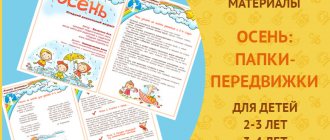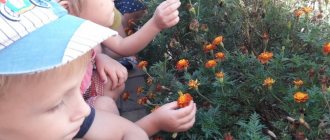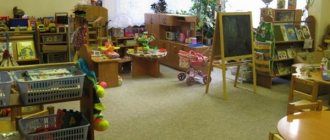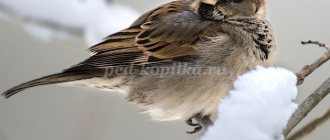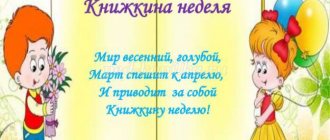Self-education plan for a middle group teacher in kindergarten
Specific topics that are relevant specifically for teachers of the secondary group relate to the following issues:
- creative development of children 4–5 years old through the use of non-traditional techniques of visual activity;
- development of dialogical speech and communication skills;
- spiritual and moral education;
- fine motor skills training;
- use of gaming activities in mathematics classes;
- formation of ideas about the culture of health.
The main selection criterion should be the difficulties that the teacher has in working with children. In order to fully master the indicated scientific and methodological problem, it is necessary to have a correctly drawn up plan for self-education.
Planning is preceded by a justification for the relevance of the chosen topic, a list of goals and objectives, expected results and intended prospects. Let's consider the typical structure of a self-education plan for a kindergarten teacher in the middle group, indicating the main forms of work.
| No. | The content of the work | Implementation period |
| Studying methodological literature. Work with documents. | September, throughout the year | |
| Familiarization with teaching experience. | September, throughout the year | |
| Carrying out introductory and final diagnostics. | September, May | |
| Selection of innovative, communication and speech techniques. | September – October, throughout the year | |
| Work with children | ||
| Conducting didactic, role-playing and outdoor games. | per month | |
| Organization of performances. | ||
| Watching cartoons. | ||
| Learning songs and poems. | ||
| Reading a story and talking about its content. | ||
| Guessing riddles. | ||
| Creation of an exhibition of drawings (photo). | ||
| Collaborative work. | ||
| Construction. | ||
| Excursion. | ||
| Working with parents | ||
| Creation of a mobile folder, information stand. | per month | |
| Selection of material for consultation for parents. | ||
| Creating a memo. | ||
| Providing recommendations and individual consultations. | ||
| Conducting a parent meeting. | ||
| Organization of joint activities with children, creative competitions. | ||
| Conducting an open lesson. | ||
| Organizing children's performances for parents. | ||
| Involving parents in creating a subject-development environment. | ||
| Self-realization | ||
| Development of lesson plans. | during a year | |
| Conducting open classes. | ||
| Preparation of a master class for teachers. | ||
| Preparation of the report. | ||
| Preparation of consultations for teachers at the teachers' council. | ||
| Presentation on the topic of self-education. | May | |
| Sharing experience. | ||
The structure of the plan can be expanded by adding the following columns:
- Objective;
- report form;
- practical way out;
- bibliography.
In May-June, it is necessary to analyze the implementation of the self-education plan, indicating the degree to which the intended goals have been achieved, identified difficulties in its implementation and future plans.
Thank you for your mark. If you want your name to be known to the author, log in to the site as a user and click Thank you again. Your name will appear on this page.
Login | Registration
Comment
Share Place on your website
Did you like the material? Want to read later? Save to your wall and share with friends
You can post an announcement of an article on your website with a link to its full text.
Copy article title
Copy article announcement
Copy link
Error in the text?
Error in the text? We are very sorry that we allowed her to do this. Please select it and press CTRL + ENTER on your keyboard.
By the way, this option is available on all pages of our website.
MAGAZINE Preschooler.RF
Long-term plan for self-education on speech development In the middle group 2022 - 2022.Compiled by: Permalova A.V. teacher
Self-education program for speech development in the middle group
Talkative people speak clearly
Clean, clear, intelligible - everyone understands.
S. Svetlova
1. Explanatory note.
By the age of four, significant changes occur in the child’s physical and mental development. However, children of this age are still characterized by instability of attention, inability to exert long-term volitional effort, and a rapid decline in performance.
A child's long stay in a preschool educational institution creates favorable conditions for systematic work on the sound side of speech. Work on pronunciation consists of the following interconnected stages:
- examination of the child’s speech and pronunciation;
- development of correct articulation;
- consolidation of correct pronunciation in free speech;
- Development of phonetic perception;
- skills of sound analysis of sentences and words.
The formation of many speech skills requires repeated repetitions (for example, when learning to clearly pronounce a sound, use a certain grammatical form of a word in speech, compose a story from a picture, memorize a poem). This is difficult to achieve in one lesson, so a speech development club is needed in preschool educational institutions. Classes are held once a week in the afternoon. All these classes are aimed at developing the child’s correct speech, which is an indispensable condition for the child’s successful education at school.
Program information card.
Type: educational
Type: author's
Level: developing
Form of classes: subgroup
Integration of educational areas:
- Speech development
- Social and communicative development
- Cognitive development
- Artistic and aesthetic development
- Physical development
- Relevance of the circle.
The age from 3 to 5 years is of particular importance for a child’s speech development. The main task of a teacher in the field of speech development for preschool children is to help them master spoken language and master their native language. The most important sources for the development of expressiveness of children's speech are works of oral folk art, including small folklore forms (nursery rhymes, lullabies, counting rhymes, fairy tales, riddles) and finger games. The educational, cognitive and aesthetic significance of folklore is enormous, as it expands the child’s knowledge of the surrounding reality, develops the ability to subtly sense the artistic form, melody and rhythm of the native language. The development of fine motor skills of the hands and fingers in children is important for the overall development of the child, since he will need precise coordinated movements to write, get dressed, and also perform various household and other movements. Consequently, hand movements are always closely related to speech and contribute to its development. Finger training affects the maturation of speech function. In other words, if the baby has dexterous, mobile fingers, then he will learn to speak without much difficulty, and his speech will develop correctly. Finger games are not only a stimulus for the development of speech and fine motor skills, but also one of the options for joyful communication. “Tell Poems with Your Hands” , and finger theater are passed down from generation to generation Based on this, I chose the topic of my circle: “The use of folk art in the development of speech of children of primary preschool age” called “Talkers” .
3. Purpose:
To develop the ability to expressively read poetry and nursery rhymes. Introduce different types of finger games.
4. Tasks of the circle:
Educational:
- Introduce children to oral folk art and Russian folklore.
- Enrich and activate children's speech.
- Learn to discuss the content of a nursery rhyme, the text of a finger game.
- Encourage activity in choosing a role, to enter into a role.
- Strengthen the ability to coordinate hand movements with the text of the nursery rhyme.
- Learn to imitate the movements of adults.
Educational:
- Develop fine motor skills, imagination, thinking, memory.
- Develop an interest in folk art.
- Develop a sense of rhythm and imaginative thinking in children.
- Develop attention and visual perception.
- Develop coordination of movements of both hands.
Educational:
- Foster love and emotional attitude towards the characters of nursery rhymes.
- Cultivate love for all living things.
- Methods for conducting the circle:
- Verbal (conversation, learning nursery rhymes, poems, riddles, Russian folk songs, texts of finger games);
- Visual - showing actions.
- Actions with the hands of a child.
- Independent actions of the child.
Club classes are held for 10-15 minutes, in the afternoon, once a week on Wednesdays.
Pedagogical analysis is carried out 2 times a year (at the beginning of the year - introductory, at the end of the year - final).
6. Calendar and thematic planning of the circle
Weeks 1 and 2 of the month - learning works of folklore, week 3 of the month - getting to know folk tales, week 4 of the month - learning finger playing.
Children attending the club
- Fadeeva Maria
- Pyrkin Kirill
- Kopeev Daniel
- Levtsova Nastya
- Churaev Arseniy
- Kuzmina Varya
- Alexandrovsky Ilya
- Zlobina Yesenia
Long-term planning of speech development classes for the 2019-2020 academic year.
September
- Didactic exercise “Who eats what?” Activate verbs in speech: lap, gnaw, etc.
- ZKR "Say A" . Pronounce the sound “a” . Find it in syllables, words (by ear).
- Learning the nursery rhyme “Finger-boy” Accustom children to listen to the teacher’s speech and repeat after him. Encourage children to pronounce words in their entirety. Learn to memorize words of nursery rhymes.
- Toy Theater “Tar Bull” Remind the content of the fairy tale, encourage them to pronounce and repeat individual words and phrases after the teacher.
October
- Didactic exercise “Tell me what you hear?” Learn to pronounce individual sound combinations clearly. Strengthen the vocal apparatus, enrich children's vocabulary.
- Looking at pictures of “Pets” Teach children to name animals independently and reproduce onomatopoeia.
- Learning the nursery rhyme “Pussy, pussy, scat pussy” Get children to pronounce words in their entirety. Learn to memorize words of nursery rhymes. Pay special attention to the pronunciation of the sound “C” .
- Toy Theater "Turnip" Remember the content of the fairy tale. Learn to retell a fairy tale, speak in the voices of the characters.
November
- ZKR “Pronunciation of the sound M” To teach children to correctly and clearly pronounce the sound “m (m)” . Learn to pronounce a sound with sufficient vocal strength. Learn to pronounce the sound m in words and verbs.
- “Magic cube” Reinforce the ability to name pictures on cubes. Answer questions about the content of the picture by repeating individual words and phrases.
- Learning the nursery rhyme “Shadow, shadow, shadow” To instill a love of artistic expression, the ability to listen and understand. Promote active pronunciation of nursery rhyme words. Explain words that children do not understand.
- Toy Theater “From the Bazaar” Introduce a new poem. A dramatization of this work. Consolidate your knowledge in the “vegetables” .
December
- KR "Sound U" . Pronounce the sound “u” . Find it in syllables, words (by ear).
- Memorizing the nursery rhyme “A fox walked through the forest” Introduce a new nursery rhyme. Learn it. Clarify unclear words. Play a nursery rhyme.
- Didactic exercise “Guests” Develop coherent speech. Remind polite words. Teach children to look at objects and highlight details. Strengthen your ability to communicate with each other.
- Toy Theater "Rukavichka" Remember the content of the fairy tale. Learn to retell a fairy tale, speak in the voices of the characters.
January
- Didactic Game “Name it correctly” Fix the words in the section “clothing” , “furniture” . Develop coherent speech.
- Learning nursery rhymes. “Like our cat” Introduce a new nursery rhyme. Learn it. Clarify unclear words. Play a nursery rhyme
- Toy Theater “Whose Voice?” Teach children to name animals independently and reproduce onomatopoeia.
February
- Didactic game “Be Attentive” Learn to recognize given sounds in words and syllables.
- Learning the nursery rhyme “The cat went to market” . Introduce a new nursery rhyme. Learn it. Clarify unclear words.
- Toy Theater “The cat went to market” Accustom children to listen to the teacher’s speech and repeat after him. Encourage children to pronounce words in their entirety. Learn to memorize words of nursery rhymes. Encourage children to repeat the words of nursery rhymes. To achieve an understanding of the content of a poetic work.
March
- Didactic Game “Bee” Develop fine motor skills of the hands. Fix the pronunciation of the sound “Zh”
- Memorizing the counting rhyme “One, two, three... No place for a bunny to jump” Introduce a new counting rhyme, develop coherent speech, achieve clear pronunciation of sounds.
- Looking at the picture “Tanya and the Pigeons” Learn to compose a story based on the picture Develop attention and memory
- Toy Theater “Grandfather wanted to cook fish soup” Introduce new poems. Play out the poem.
April
- Speech game “Car” Introduce a new game. Achieve clear pronunciation of words.
- Learning “Lullaby” Develop the ability to raise and lower your voice.
- Dramatization of the fairy tale “The Wolf and the Seven Little Goats” Remember the content of the fairy tale. Learn to retell a fairy tale, speak in the voices of heroes
May
- Didactic Game “Echo” Develop hearing, attention, speech. Repeat words after the teacher and peers.
- Game "Who does what?" Answer questions about the content of the picture by repeating individual words and phrases. Teach carefully, look at the picture and name the objects and actions of people depicted on it.
- Fairy tale kaleidoscope. Consolidate knowledge about fairy tales that have been read throughout the year.
| Next > |
Theoretical aspects of self-education
A good teacher cannot be passive - this is an axiom. Moreover, professional activity is important not only for the individual himself, but also for creating a positive image of a preschool institution, because parents, when choosing a kindergarten for their child, are interested in how proactive the teacher is who will work with children of a particular group. In addition, improving professional skills through self-study is a requirement of the Federal State Educational Standard (FSES) and is reflected in the teacher’s competence, qualifications and salary. Self-education is a purposeful, conscious, active cognitive activity of a teacher, aimed at improving the methods of working with students, enriching one’s own teaching experience in accordance with the modern level of development of pedagogy and psychology.
Always learn, know everything! The more you learn, the stronger you will become.
M. Gorky
https://www.aforism.su/73_5.html
Self-education is a combination of studying the experience of the past and introducing elements of modern pedagogical technologies
According to the Federal State Educational Standard, the educator’s efforts aimed at self-education are based on the need to achieve the following goals:
- get acquainted with and master new pedagogical technologies;
- systematize the work on finding methods to improve the educational process for children in the middle group;
- create conditions for the comprehensive development of wards (physical, mental, mental, emotional).
To achieve your goals, you should work on solving the following tasks:
- learn to apply modern pedagogical technologies in personal practice;
- develop cognitive, labor, and play activity in children;
A variety of didactic games allow children to develop their cognitive activity.
- constantly improve your level of proficiency in methods of working with preschoolers;
- study classical and modern methodological approaches related to the chosen topic of self-education;
- make attempts to generalize and disseminate their own experience.
Principles of self-education
In his work on professional self-improvement, the teacher must be guided by certain principles:
- Continuity. Work on the chosen topic involves its comprehensive coverage throughout the academic year (sometimes 2-3 years).
- Continuity and interconnection. The next topic should be related to the previous one. For example, if a teacher has taken up the topic of spiritual and moral education of preschoolers of the middle group, which implies consideration of the issue in general, then after finishing the work it is logical to take on a more specific aspect, for example, “Spiritual and moral education of children through reading fiction.” Thus, the previous requirement - continuity - will be observed not just within the framework of consideration of one topic on self-education, but in general throughout the entire methodological work of the teacher.
- Compliance with the goals and objectives of the educational process in kindergarten. That is, for institutions that are developing hardening systems, this component should be included in all possible topic formulations. And if a kindergarten works with children who have certain developmental disabilities or health problems (for example, the team cares for children with poor vision), then the topic of the self-education program should reflect this aspect both in the theoretical block and in the practical one.
- Availability of putting theory into practice with a specific group of children. For example, as part of the study of the topic of non-traditional drawing techniques, creating images with soap bubbles in the middle group will not be entirely appropriate, since children do not yet have the required skill in creating the directional movement of an air stream using a breathing apparatus.
The teacher’s task is to find a methodological explanation of this or that technique so that the child can cope independently
It is important. Advanced training is a necessary condition for life in today's rapidly changing world.
Forms of organization of activities
The process of teacher self-education can take place in the following forms:
- Individual: visiting libraries;
- study of scientific, methodological and educational literature on the topic;
- visiting classes of teachers of other groups;
- participation in kindergarten teacher councils and meetings of the methodological association of preschool teachers in the city;
- theoretical development and practical testing of various forms of classes and activities.
The individual form includes independent preparation, selection of information and preparation of a report-speech on the implementation of the idea of self-education
The choice of forms of work depends on which of the participants in the educational process the teacher interacts with at the moment of mastering the topic:
- With kids. Such interaction is realized in the process of educational activities and during leisure time. Takes the form:
- training sessions;
- various kinds of games (including didactic, outdoor);
- walks.
- With parents. Carried out in the form:
- consultations;
- round table meetings;
- pedagogical trainings, during which parents receive practical recommendations, for example, on the speech development of children 4–5 years old.
- With colleagues. This is achieved through the joint organization of master classes, meetings of pedagogical councils, and the methodological association of educators working with a specific age group of children, where opinions are exchanged on the organization of classes, content and teaching methods. Carried out in the form:
- presentations;
- reports;
- publications on resources related to education;
- articles in magazines and other printed publications.
